231 fellow truck campers rip the Band-Aid on off-road boo-boos and boldly proclaim their stance on Team Battle Scars or Team Bubble Wrap. Then the reader stories take it over the edge!
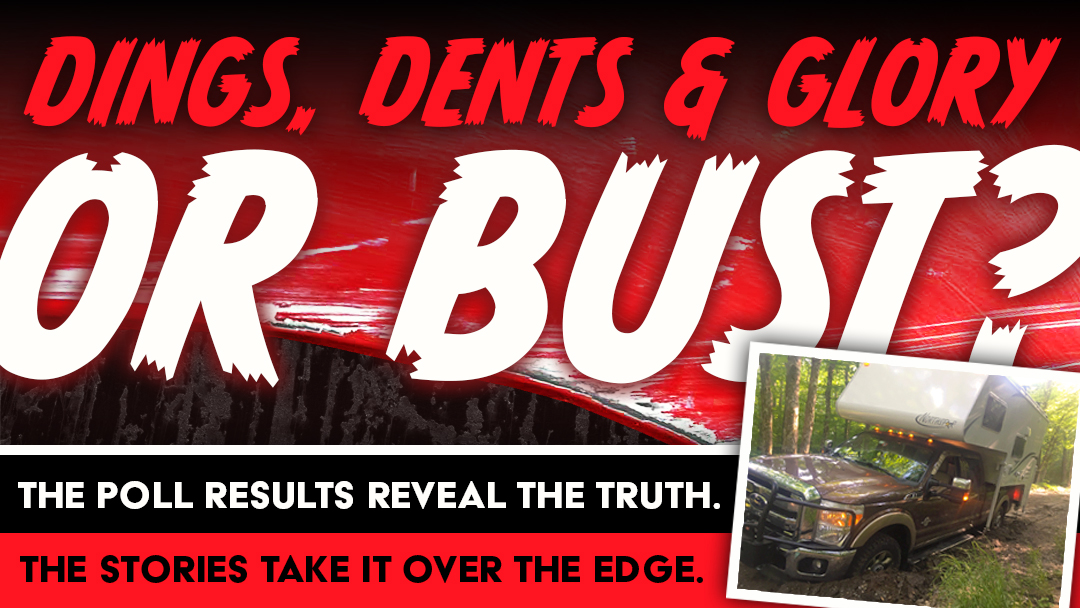
Last week we asked Truck Camper Magazine readers to throw down and answer the ultimate off-road question: Are you willing to embrace scratches and dents as badges of honor in pursuit of breathtaking, off-the-grid views and experiences? Or does preserving your rig’s pristine condition take priority, even if it means turning back?
Buckle up butter cups! Things get interesting fast. And how…
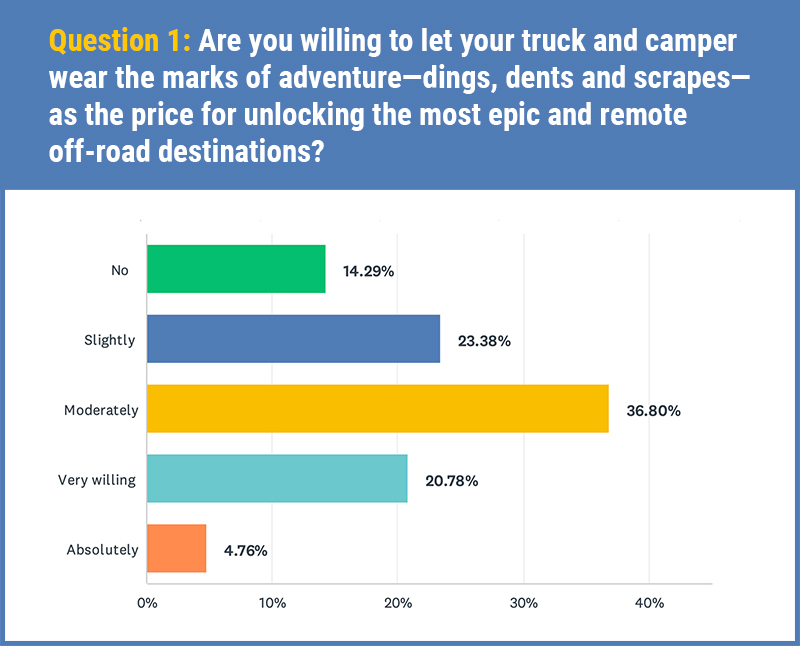
1. Are you willing to let your truck and camper wear the marks of adventure—dings, dents and scrapes—as the price for unlocking the most epic and remote off-road destinations?
We simplified the graph above for legibility, but here are the full-length responses from the survey rounded up to the nearest tenth:
No – My truck and camper must stay pristine; I avoid any damage. 14.3%
Slightly – I’ll accept minor scratches but avoid anything more serious. 23.4%
Moderately – Some dings and scrapes are okay, but I try to minimize them. 36.8%
Very willing – I embrace the wear and tear as part of the adventure. 20.8%
Absolutely – The more battle scars, the better! 4.8%
What’s impressive is that 85.8% of us are willing to accept some level of damage to our rigs for the sake of the lifestyle and experience of truck camping. Eighty-five percent!
I would bet my stockpile of vacuum tubes that the results would be inverted if we put the same question to motorhome and towable RV owners. It may seem trivial, but I believe this is a major difference between truck campers and RVers. We’re in it for the adventure. Our rigs are the tools to have that experience.
New Idea: We Need a Beater Rig!
Now, I must admit I personally struggled a bit with this question. I ultimately selected moderately as we are 100 percent willing to scratch our rig for the experience of seeing something amazing, but would prefer not to.
What occurred to me as I made that selection is that we need a beater rig: a truck and camper that’s past its prime, already taken a few off-road hits, but runs perfectly. Then we really wouldn’t give a turnbuckle hook what we scraped, dinged, or dented. In fact, it could be part of the fun!
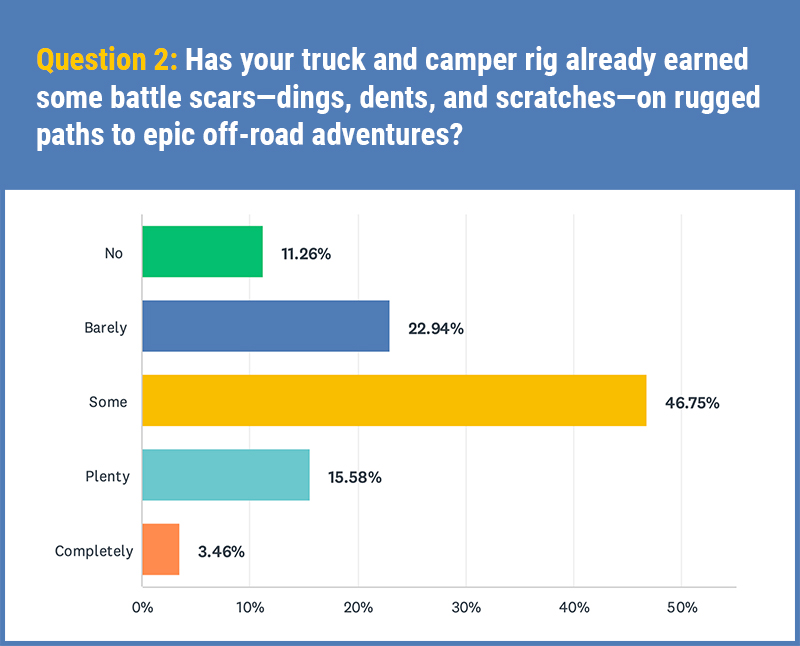
2. Has your truck and camper rig already earned some battle scars—dings, dents, and scratches—on rugged paths to epic off-road adventures?
Again, we simplified the graph above for legibility, but here are the full-length responses from the survey rounded up to the nearest tenth:
No – My rig is still in showroom condition, and I plan to keep it that way. 11.3%
Barely – Just a couple of minor scratches, but nothing noticeable. 22.9%
Some – I’ve picked up a few dings and scrapes, but nothing major. 46.8%
Plenty – My rig has taken a beating, but that’s just part of the journey. 15.6%
Completely – My rig is covered in scars, each one a story of adventure! 3.5%
Oh, how I wish we had photos of the 3.5% of folks who said their rig is completely covered in scars! If you’re reading this, please send us some pictures!
Here’s a funny reality: 85.8% said they want their rigs to stay pristine in question one, but 88.8% reported some level of scratches or damage to their rig from truck camping.
Unless you’re starting a truck camper museum, your rig should have at least a few scratches. That’s called being in a Walmart parking lot when someone leaves their cart behind, the wind catches it and steers it into your rig. That’s called going down a road that turns to dirt, then turns into one lane, then collapses in with scrubs and tree limbs with no place to turn around for a mile. That’s called finding a scrape on your rig and having no idea where in the past few thousand miles that happened. All of this and more has happened to our rig. Sound familiar?
Where the dang ding did that come from? That’s truck camping!
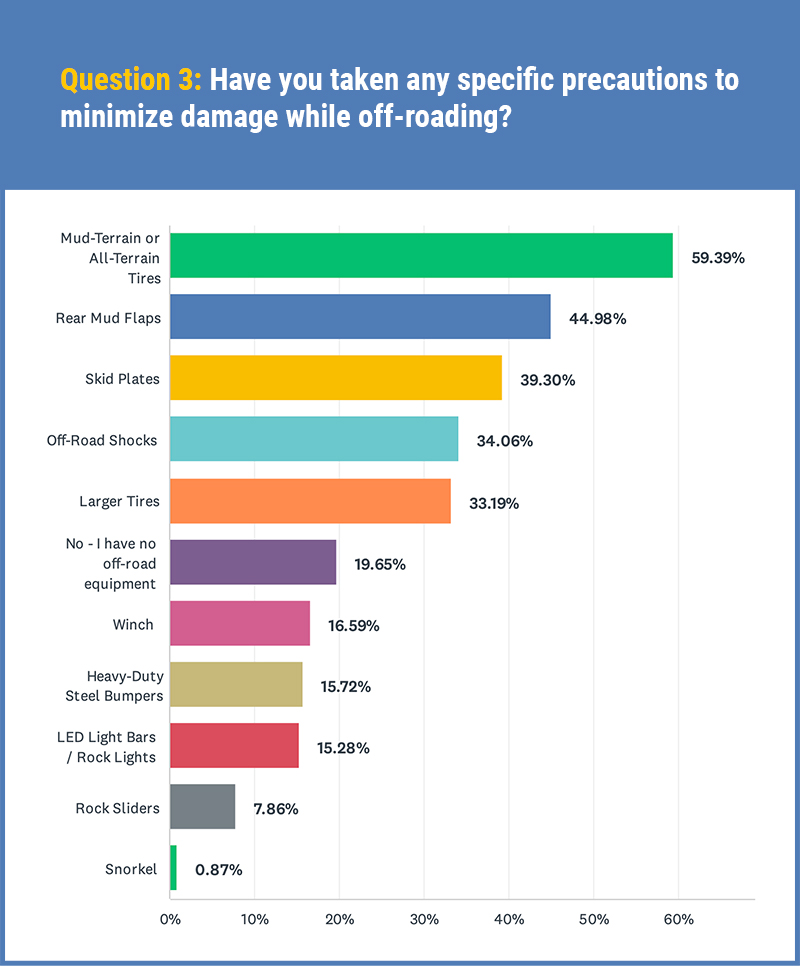
3. Have you taken any specific precautions to minimize damage while off-roading?
We were curious to learn what kinds of aftermarket equipment readers might have installed on their rigs to avoid or absorb off-road damage. To keep the conversation focused, we listed the more popular off-road accessories and let respondents click all that applied to their set-up.
Looking at the graph as a whole, you can see five items were selected by roughly one-third of fellow truck campers: Mud-Terrain or All-Terrain Tires (59.4%), Rear Mud Flaps (45%), Skid Plates (33.3%), Off-Road Shocks (34%), and Larger Tires (33.2%). If you’re looking to enhance your rig’s ability to off-road, these items are a good place to start.
On balance, 19.7 percent said they have no off-road equipment. I suspect that these respondents view their truck clearance, four-wheel drive, and suspension to be already capable of whatever off-road interest level they have. It’s like starting with a Jeep instead of a Toyota Camry. With a truck camper rig, you’re ready to go off-road to some level right off the bat. From my many conversations with off-road enthusiasts who are far more experienced than us, I have learned that knowing and respecting your off-road knowledge is the key. Don’t wind up like this:
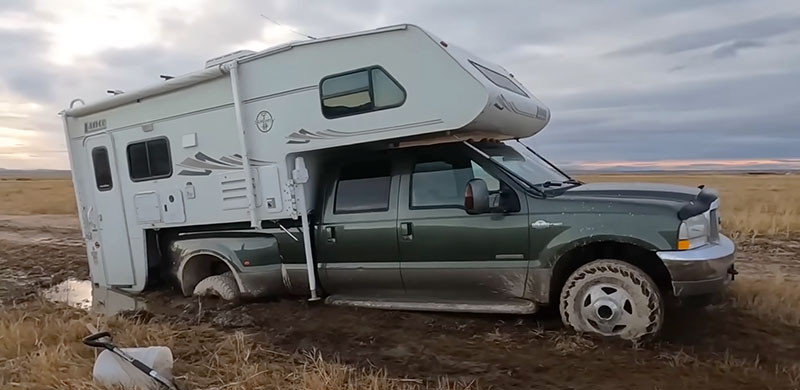
Above: To read the insane story behind this picture, check out, “Sunk Camper Rescue Mission”.
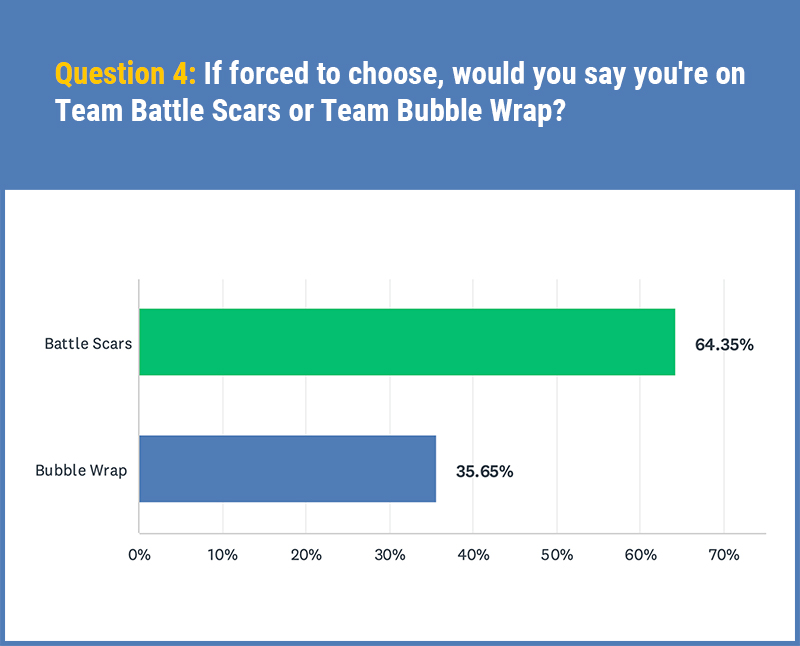
4. If forced to choose, would you say you’re on Team Battle Scars or Team Bubble Wrap?
There comes a time in life when you have to make declarations. Are you going to this school or that? Taking this job or that? Marry this person or that? Beatles or Stones? Dogs or cats? Crew cut or mullet? Life can be relentless with these difficult decisions.
Of course all of those pale in comparison to what we set up here. For our final question, we forced you to declare whether you’re on Team Battle Scars (bring on the rig damage, if necessary) or Team Bubble Wrap (keep our pretty rigs pretty, please).
With hands over my eyes, I chose Battle Scars. In my heart, I hate to see our rig get damaged, but experience has taught me that damage is part of the game. Heck, we had a Camry plow into us at 40 miles per hour on a straight paved and otherwise unoccupied road. Talk about a ding.
Bonus: Do you have a personal story about a time your rig took a hit while off-roading? If not, have you ever turned back from an off-road route because the potential for damage seemed too high?
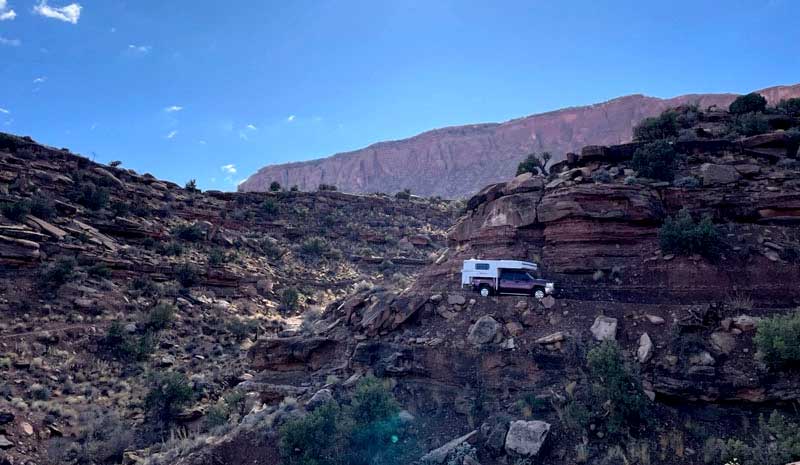
“Our family has spent the last two Thanksgivings boondocking in Utah. The first year we went to the Capitol Reef area and last year we did the Moonhouse Ruins and Natural Bridges Nation Monument. The trip into the Moonhouse Ruins started at the Combs Campground and proceeded along Utah 235 and 237, roughly 23 miles of dirt roads. The attached picture is along that trail. To get to Natural Bridges NM we had another eight miles of dirt. Great trip, good food, and beautiful country.” – Robert Wallen, 2013 Chevy 2500HD, 2018 Northstar 850SC
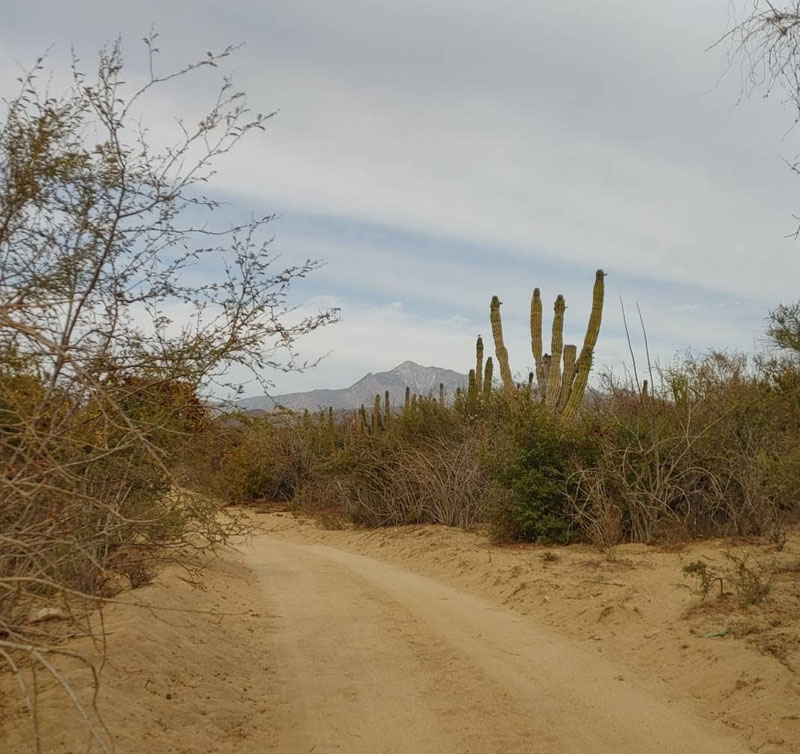
“I built my camper with the purpose of exploring North America and maybe even beyond. My maiden voyage was to Baja California Sur and was full of adventures and battle scars. While Baja is known for its amazing beaches, it’s also known for its rugged backcountry.
I prefer to travel off the beaten path and on the old dirt and sand roads. Adventure comes at a cost since a lot of remote areas aren’t necessarily conducive to medium-duty truck with a truck camper.
I had lots of encounters with Mango tree branches, thorns, cactus, and the like. Some people fondly refer to it as desert pin striping.” – Kris Rodriguez, 2009 Ram 4500, Custom 10ft Total Composites cabover
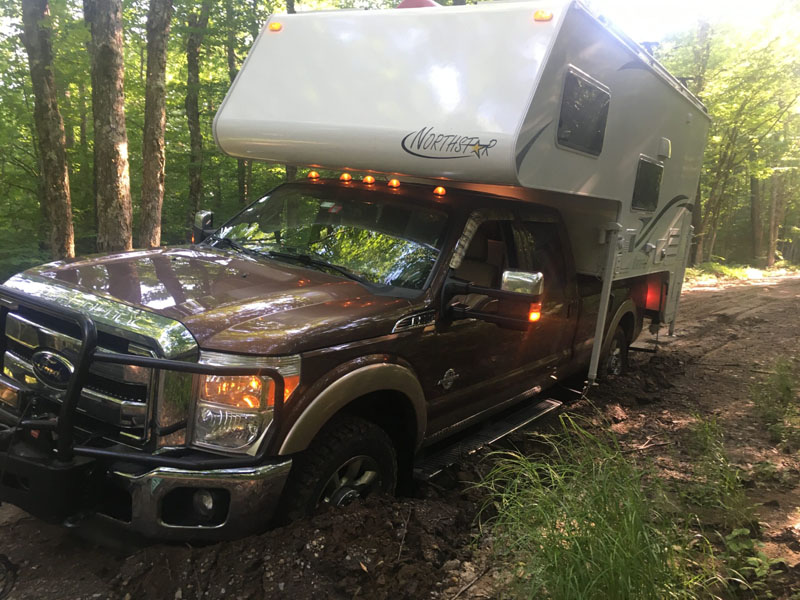
“My first story happened just before we went full-time in our truck camper in June of 2019. I was traveling into the Moose River Plains in the Adirondacks of New York (alone) to meet my husband and friends for a long weekend.
Despite knowing this area well, I ending up getting my Ford F-350—fully loaded with my brand new truck camper—stuck! I was twenty miles away from the closest town and had absolutely no cell service.
However, I came prepared. Two weeks prior, we had a winch installed on the front of the truck. The problem was, I never used it before and had only watched a YouTube video about it. Well, let’s figure it out on the fly.
I got the cable wrapped around a tree, turned on the winch and it was working great, moving the truck slowly but still not well. After a few seconds, I realized that—in my panic—I still had the truck in park!
After putting the truck in neutral, I got out of the stuck situation with ease. No damage, lots of lessons learned, and a funny story to tell.
My second story, also in 2019, was just after selling our house and moving full-time into our truck camper. Boy, we learned a lot that year!
We were in Colorado in Pikes Peak National Forest. We had a gorgeous camping spot with views of snow-capped mountains off in the distance. We spent a few days enjoying the views and nearby hiking. On our way out we decided to continue down the road we were camped on. On the map, it looked like it circled out a different way. Cool! Maybe we will find something fun.
Well, I wouldn’t call it fun. More stressful. The road started to deteriorate and there was no place to turn around. At one point the road even had a twelve-degree pitch! Not fun in a truck camper. We continued our way very slowly when we got to a spot where the trees were too low to get past.
At this point, we had to ignore the “no cutting of trees” rule in this National Forest and cut a few branches. Kevin climbed onto the front cattle guard of our truck and started cutting the branches.
Sadly, one fell quicker than expected and landed on Rosie’s hood where she proudly wears the battle scar to this day. But the story is not over!
We still had three-tenths of a mile to go! We got under those trees, but then there were trees that were too close together. In order to get past them we had to go around them by entering a nearby campsite. We humbly asked permission, they said yes with raised eyebrows as if to say, “How the hell did you get here?”
As I drove past, Kevin spotted to make sure we didn’t hit anything. I thanked the campers and said, “This will be fun, he said!” We all laughed, I almost cried, and I got back onto a good road with a few scratches on the camper, a dent on the hood, and another good story to tell.
There was also the time we broke a U-joint trying to get to some hot springs but I’ll save that story for another time. I think Rosie is happy that we got the Jeep.” – Kami Golembeski, 2011 Ford F-350, 2019 Northstar Igloo U
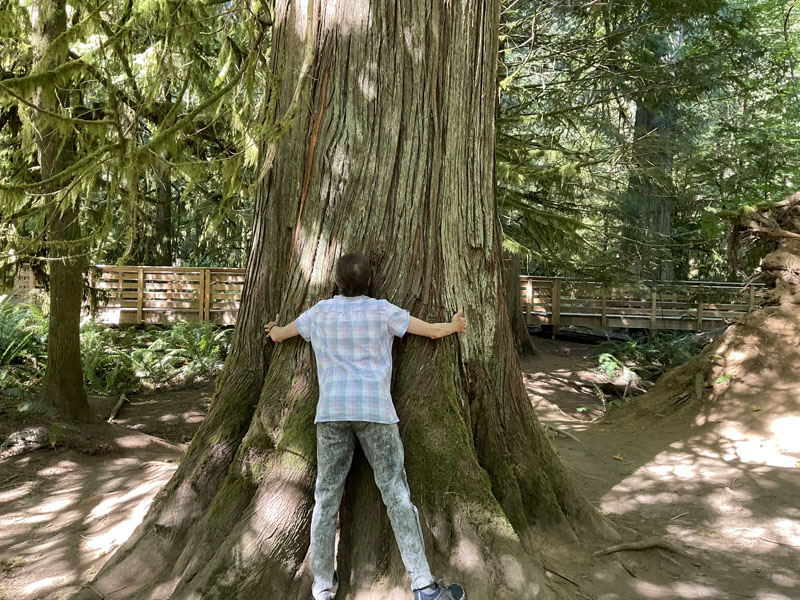
“Yes, we turned back on July 26, 2022. We were on a logging road that would lead us to “The Big Lonely Doug”, Canada’s second-largest Douglas Fir that’s 1,000 years old; 230 feet high, and 12.8 feet in diameter. The tree was spared from being cut by Mr. Cronin.
A logging truck was coming our way and there was no way he would try to avoid us. We were lucky to have room to move right, otherwise I would not be here to tell the story. Our lives are very precious so, we turned back and instead went to Cathedral Grove (pictured above) to see some big trees, one of which was approximately 800 years old.” – L. and S. Gagnier, 2020 Chevy Silverado 2500, Camplite 6.8
“My story happened while backing into a very tight squeeze at the secluded dead end of a decommissioned forestry road, immediately beside a clear running creek. I failed to see one tree branch, which of course broke my rear awning mechanism.
My second story happened while I stood on top of my truck hood—with my Dewalt chain saw—cutting hanging branches off a tree overhanging a lovely remote forestry road at a lovely lakeside hideout. I discovered that I could not in fact totally sneak under the overhanging tree as my fridge vent top scraped and cracked.
Both locations were Northern Vancouver Island, British Columbia, Canada.” – Leah Wheeldon, 2012 Ford F150, 2016 Westland Travelaire 7.6
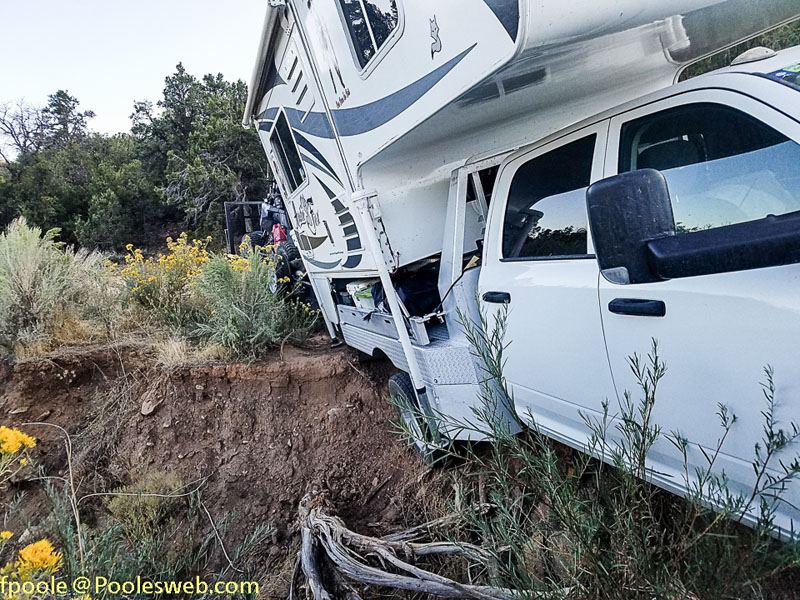
“I just can’t resist a dirt road going down to somewhere. On one such jaunt, I got caught in a hidden ditch and would have rolled down a 30-foot cliff were it not for some small steel beam holding my camper on the ledge from going over. More than six nighttime hours and some $1,700 with two operators got it back on the narrow one way trail/road again.
I’m an old Geezer at 78 years old, so I now avoid the temptation to go down those dirt roads. My Arch Nemesis, Ms. Garmin, takes me there and then dumps me with “..unable to find…” or whatever. I’ve been caught too many times, so I shy away sadly. I’ve had four tires in the air with the trailer saving it all as an anchor.” – Frank Poole, 2016 RAM 5500, 2016 Arctic Fox 990
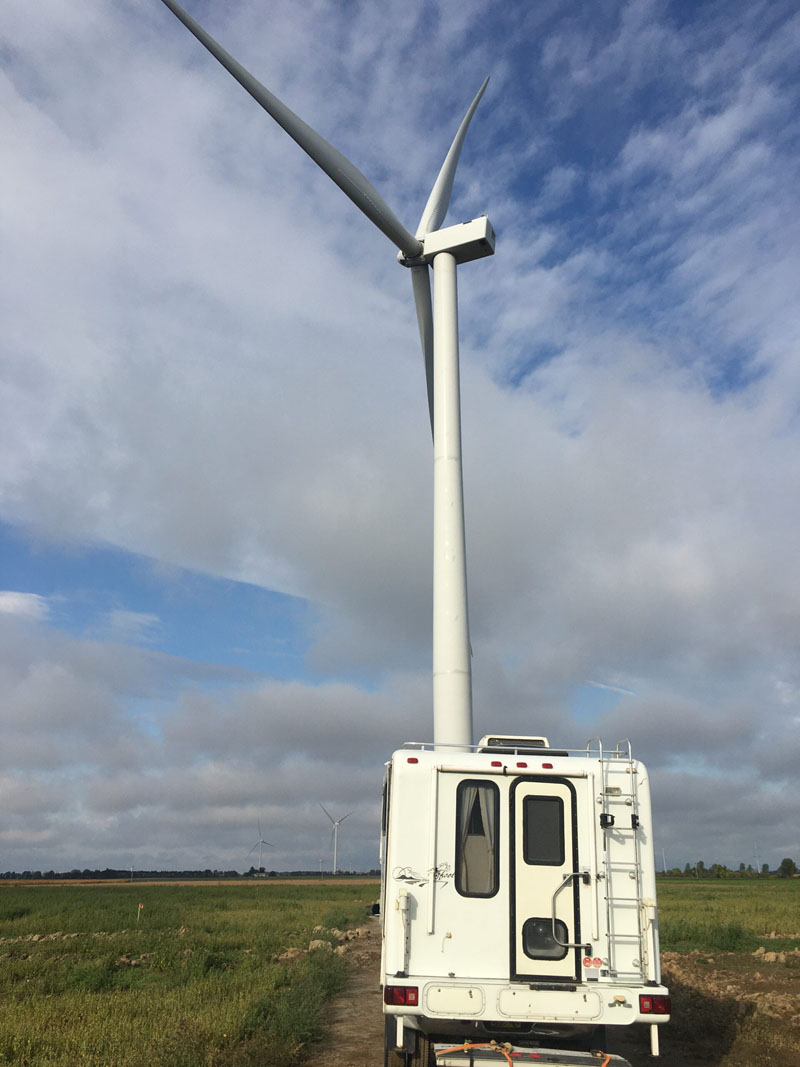
“I took my camper to Prudhoe Bay, Alaska from Fairbanks, and crossed through the highest mountain pass in Alaska called Atigun. The road is gravel most of the way and state DOT uses chloride to keep the dust down.
It formed a hard and slick service that day as it was raining. I had to use four-wheel-drive to keep from slipping off the road and down the mountain.
Once through, the pass breaks out on the North Slope where there are no trees. Being that it’s a haul road to the oil fields, heavy semis are going extremely fast. I traveled with a neighbor and would pull off and stop when other trucks were coming at us. I still had a softball size rock smash the windshield, although didn’t penetrate.” – Brent LeValley, 1996 Dodge 3500, 2000 Bigfoot 3000 Series
“We turned around at the beginning of the four-wheel drive portion of the “road” to Chorro Vista campsite in Big Bend Ranch State Park, Texas. I was already in four-wheel drive and the truck was taking a beating on the high clearance section. That experience changed my approach to that park on subsequent visits.” – Limestone Farrell, 2020 GMC 2500, 2021 Palomino SS-1240
“We’ve explored some of the backroads of northern Wisconsin, Minnesota, and the Upper Peninsula of Michigan. One of the fun adventures was a nine-mile one-way two-track to Crisp Point Lighthouse. It was all sand and through Jack pines. It was a great day!” – Dave Miller, 2022 Ford F-350, 2002 Bigfoot 10.6
“I lost a roof antenna as the result of some low-hanging branches. We actually trimmed branches to gain access, but unfortunately, they got us anyway. When we got home we looked for a replacement. The antenna had been discontinued by the manufacturer, but I was fortunate to be able to purchase the last new unit available in their warehouse.” – Stephen Paige, 2018 Ford F-350, 2020 Real-Lite HS-1914
“Yes, we turned back, but only because we forgot the chainsaw.” – Norm Cushard, 2005 Chevy Silverado 3500, 2016 Palomino HS-8801
“Exploring the Colorado Rockies, we wanted to visit a particular valley. Approachable from below only by hardcore Jeeps, a study of topo maps and Google Earth showed a route from above the treeline. Three-quarters of the way down we hit a tight squeeze between medium-sized pines about eight feet above ground level. Porcupines? Or camper damage? Hmmm…
Turn around? Nevah! Measuring showed six inches of clearance on both sides so—with my brother spotting—I eased forward. The truck tilted left, then right as the front axle rolled over some rocks. Dorward… rear axle, left, right, and we were thru.
“Uh, you might wanna come look at this.”
Those tilts were timed to scrape off the latches on our ancient pop-up Hallmark. We did the next 1,800 miles with the top held down by ratchet straps.” – Christopher Heiny, 2017 Ram 2500, 2015 Northstar TC800
“Having been a professional (sponsored) off-road race driver, an auto body tech, a worker in the outdoor industry much of my life, and growing up camping, I’ve been on both Team Battle Scars and Team Bubble Wrap.
I’ve had concourse trucks that I have scarred. I’ve retreated from the most fabulous potential adventures rather than face the potential consequences.
My current rig—a 2004 Ford F-550 with a Bigfoot 3000—is no exception. Having had multiple rigs, I have multiple stories of such events, but the better stories are of the times I’ve risked it, and amazingly, survived without scars, even though scarring things happened.
The scars that are forever in my mind, those what was I thinking moments, are really the more exciting stories, all of which are true!” – Matt Fen, Ford F-550, 2004 Bigfoot 3000 C1002
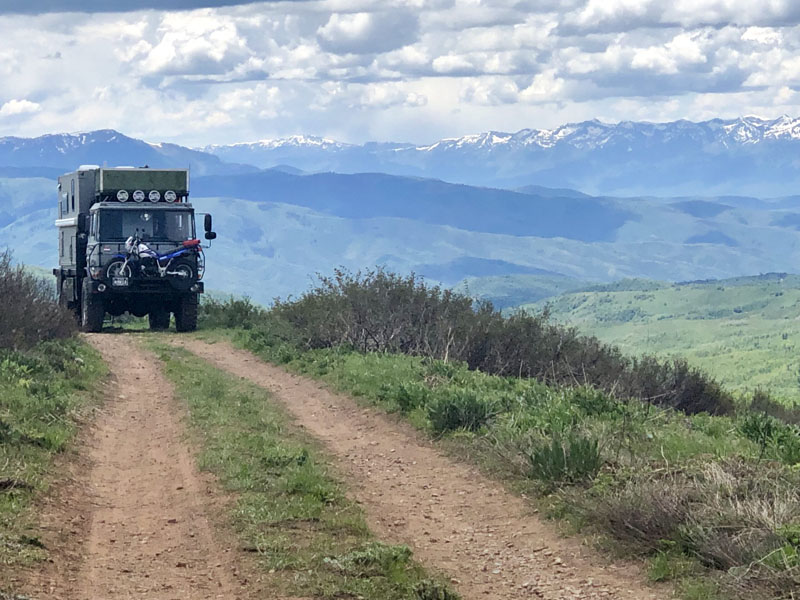
“I’ve had to make choices in my backcountry travels. Can we keep going? Should we keep going? Is it safer to turn around? Can I turn around? Will that bridge hold my weight? Are the trees too low? Will that rock take out the side wall on my tires? How close can I get to the road edge before it crumbles and falls away? Such is the challenge of driving a twelve-ton off-road rig. But so far, we’ve made it through.
As I look back on the challenges, the memory of a 100-mile section of muddy single-lane forest and shelf road passes along the continental divide in New Mexico comes to mind.
But it’s the three-mile section of the Canol Road going into Ross River, Yukon Territory just north of the Campbell Highway that put me in a sweat. It’s just three miles of steep climbing and downhill…” – Jeff Nabity, 1981 DAF YA-4440, Custom Fokker Habitat
